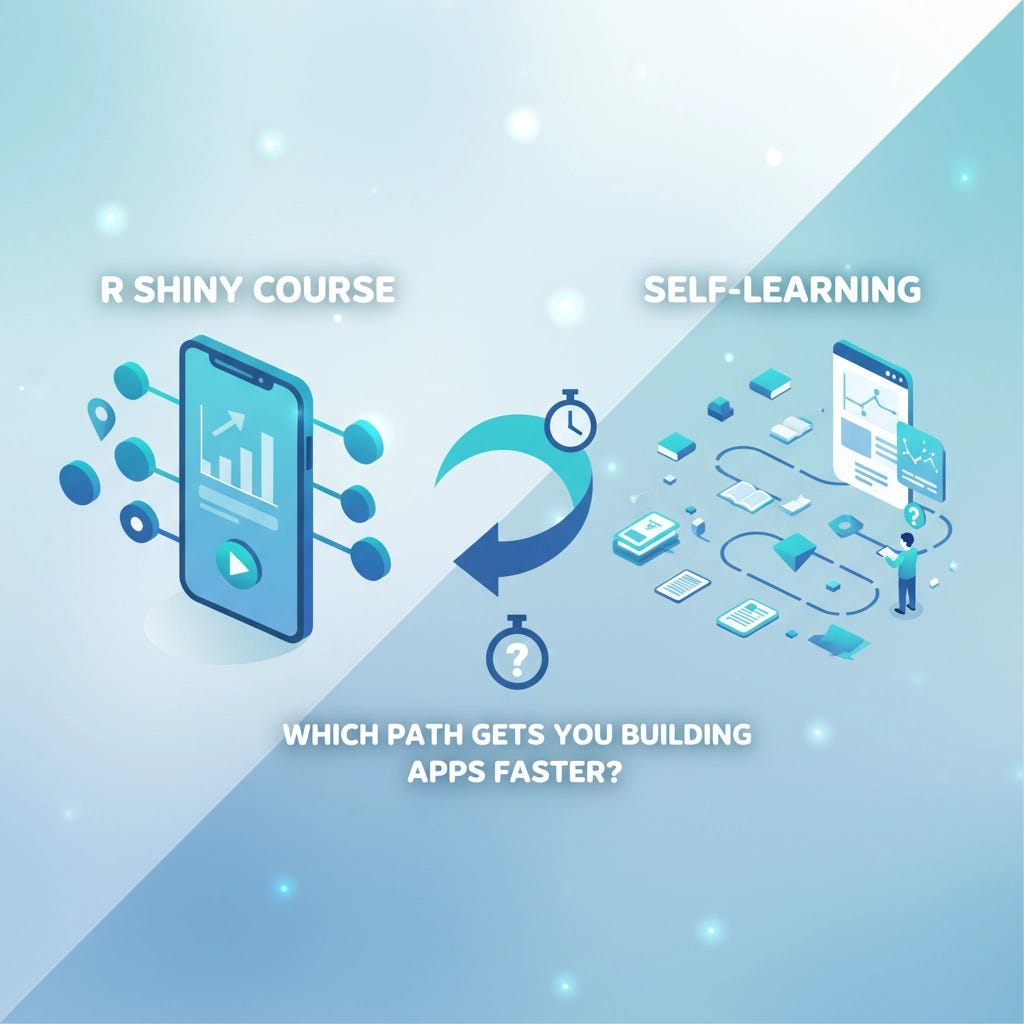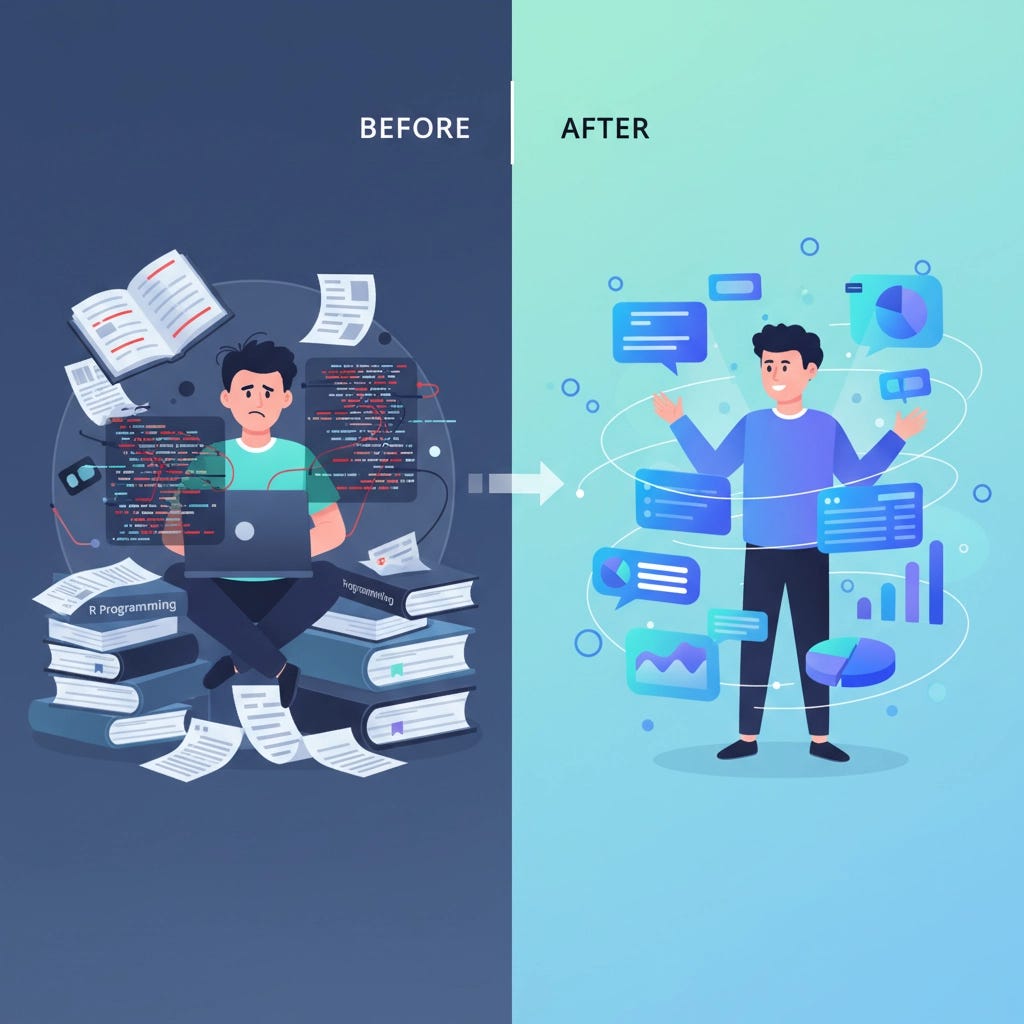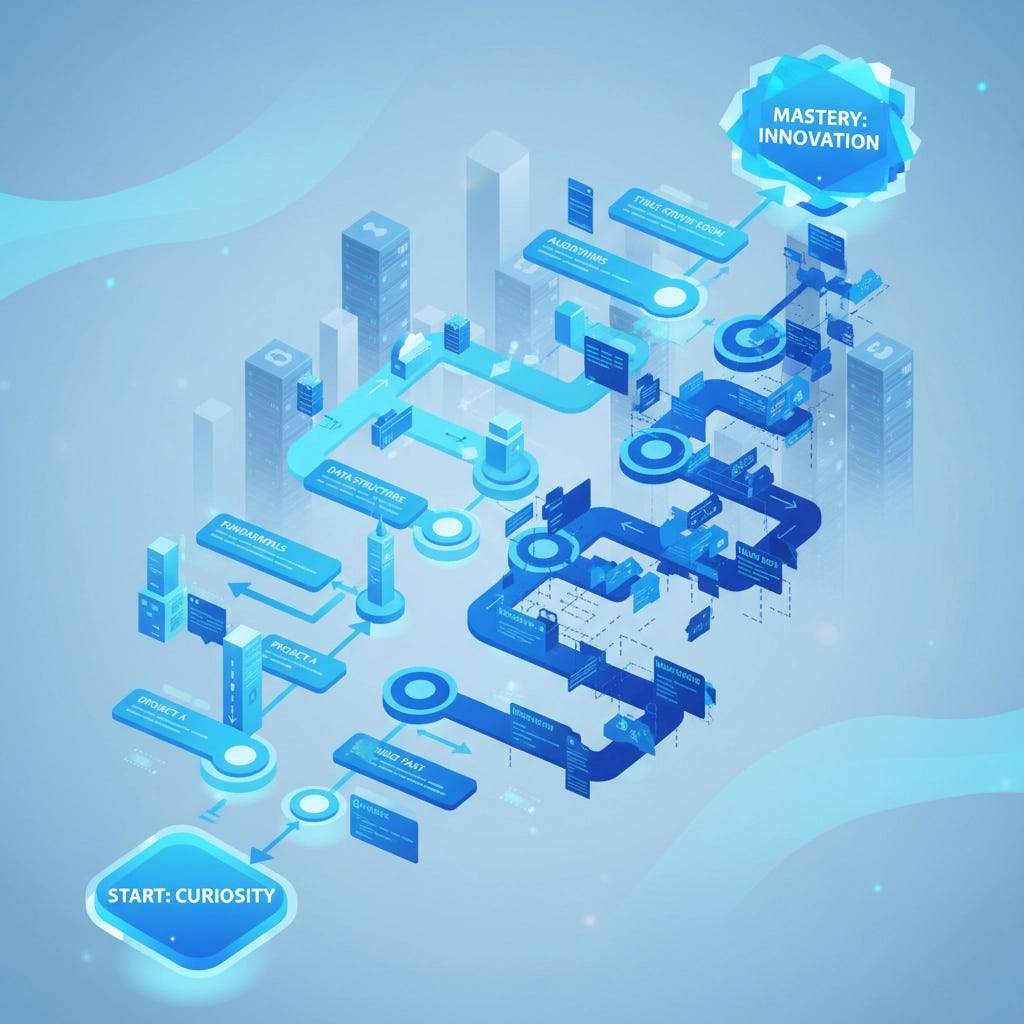R Shiny Course vs. Self-Learning: Which Path Gets You Building Apps Faster?
The answer isn't what most people think.
You’ve got a data visualization project deadline breathing down your neck. Your stakeholders want an interactive dashboard, not another static PowerPoint. R Shiny seems like the perfect solution: but here’s the million-dollar question: Should you dive into a structured course or teach yourself through documentation and tutorials?
The answer isn’t what most people think. Speed to building functional apps depends far less on your learning method and much more on three critical factors: your existing R foundation, project complexity, and how quickly you can debug inevitable roadblocks.
Why Shiny Changes the Game for Rapid App Development
Shiny fundamentally disrupts traditional web development timelines. Unlike building applications with JavaScript frameworks or Python’s Django, Shiny requires zero knowledge of HTML, CSS, or JavaScript to create functional web applications. This accessibility factor is precisely why data scientists can prototype interactive dashboards in hours rather than weeks.
The framework’s reactive programming model means your R code automatically updates outputs when inputs change: no complex event handling or state management required. This design philosophy favors rapid iteration, whether you’re following a structured curriculum or cobbling together solutions from Stack Overflow.
The Structured Course Advantage: When Formal Learning Accelerates Development
Immediate Access to Production-Ready Patterns
Structured courses deliver battle-tested architectures from day one. Instead of spending hours debugging why your app crashes with larger datasets, quality courses teach performance optimization and scalability patterns upfront. You’ll learn about reactive expressions, proper module design, and database connections: knowledge that prevents costly rewrites later.
The Athlyticz R Shiny courses exemplify this approach by combining fundamental concepts with real-world project development, ensuring you build portfolio-ready applications rather than toy examples.
Meet Your Instructor
All R Shiny courses are led by Veerle Eeftink – van Leemput, a seasoned Shiny developer and co-author of shinyMobile, with 8+ years experience.
Course Lineup
ProductioniZing Shiny: 80+ lessons, beginner-to-advanced, from building your first app to professional best practices.
CustomiZing WidgetZ: Dive into technical skills like creating custom widgets (HTML/CSS/JS) and package development. Perfect for experienced users wanting deeper knowledge.
Mobile StructureZ: Specialized in developing Shiny apps for mobile—learn shinyMobile, optimize for devices, and publish PWA or App Store-ready apps.
Why Learn on Athlyticz
All courses are delivered on Athlyticz’s online platform with virtual machines, so no installation is required and the right packages are always available.
Anytime, anywhere access; learn at your pace with zero installation required
Platform provides hands-on exercises, quizzes, and a completion certificate
Content includes fun sports-world examples (but open to all fields)
Created by top experts like David Granjon (RinteRface maintainer)
Systematic Skill Building Prevents Knowledge Gaps
Self-learners often master complex visualizations while missing basic deployment concepts. Courses enforce comprehensive skill development, covering everything from UI design principles to server optimization. This systematic approach prevents the frustrating scenario where you can build impressive prototypes but can’t share them with stakeholders.
Structured Problem-Solving Frameworks
When your Shiny app breaks (and it will), courses provide debugging methodologies. Instead of randomly trying solutions, you’ll have systematic approaches for identifying performance bottlenecks, fixing reactive dependencies, and optimizing render functions.
The Self-Learning Route: When Independence Drives Faster Results
Project-Driven Focus Eliminates Learning Overhead
Self-learners can immediately tackle their specific use case without working through irrelevant curriculum. If you need a financial dashboard, you can focus exclusively on finance-related packages and visualization types rather than spending weeks on general concepts you’ll never use.
This laser focus particularly benefits developers with strong R backgrounds who need Shiny for one specific project type.
Unlimited Learning Velocity
No course schedule constraints mean you can sprint through familiar concepts and slow down for challenging areas. Strong self-learners often build functional prototypes within 48 hours because they can skip theoretical foundations and dive straight into implementation.
Access to Cutting-Edge Solutions
The R community constantly develops new Shiny extensions and packages. Self-learners can immediately incorporate the latest tools like bslib for Bootstrap theming or plotly for interactive graphics, while course content might lag behind current best practices.
What Actually Determines Your Speed to First App
Your R Foundation Matters More Than Learning Method
Developers with solid R skills (data manipulation, visualization, function writing) build apps 300% faster regardless of learning approach. If you’re comfortable with dplyr, ggplot2, and basic programming concepts, both paths will get you to functional applications quickly.
However, if you’re still struggling with R fundamentals, a structured approach prevents compounding confusion as you simultaneously learn language syntax and application frameworks.
Project Complexity Drives Timeline Reality
Simple dashboards with static data can be built in hours through either approach. Multi-user applications with database connections, authentication, and real-time updates require systematic architecture knowledge that courses deliver more efficiently than trial-and-error learning.
Debugging Capability Determines Success Speed
The fastest path to building apps is avoiding common pitfalls that derail development. Courses teach you to recognize and prevent typical Shiny mistakes:
Reactive dependency loops that crash applications
Memory leaks from improper object handling
Performance issues from inefficient data processing
Deployment failures from dependency conflicts
Self-learners often encounter these problems without context for quick resolution, leading to development delays that structured learning prevents.
The Definitive Speed-to-App Recommendations
Choose Structured Learning If You:
Have limited R experience (less than 6 months regular use)
Need production-ready applications with user authentication and database integration
Work in teams requiring consistent development patterns and code standards
Value comprehensive skill development over immediate project completion
Recommended action: Enroll in focused Shiny training like Athlyticz’s Shiny courses that combine theory with hands-on project development.
Choose Self-Learning If You:
Have strong R fundamentals and experience with data manipulation packages
Need simple, single-purpose applications without complex user management
Learn effectively through experimentation and have high tolerance for debugging
Have immediate project deadlines and can’t commit to course schedules
Recommended action: Start with RStudio’s official Shiny tutorial, then immediately begin building your target application while consulting documentation as needed.
The Hybrid Approach: Maximum Speed with Minimum Risk
The fastest developers combine both approaches strategically. Spend one focused weekend completing a comprehensive Shiny foundations course to establish proper patterns and debugging skills. Then immediately pivot to self-directed development for your specific project.
This approach delivers structured knowledge for preventing major mistakes while maintaining the speed and focus advantages of project-driven learning.
Critical Success Factors Regardless of Path
Master the Development Workflow Early
Whether you choose courses or self-learning, establish efficient development practices immediately:
Use RStudio’s built-in Shiny debugging tools for faster error identification
Implement version control to prevent losing working versions during experimentation
Test on different browsers and devices early in development rather than discovering issues at deployment
Focus on User Experience from Day One
Technical functionality means nothing if stakeholders can’t use your application effectively. Prioritize intuitive UI design and responsive performance over complex features that impress fellow developers but confuse end users.
Plan for Deployment and Maintenance
The fastest path to building apps includes planning for sharing and updating them. Whether using shinyapps.io, RStudio Connect, or custom servers, understand deployment requirements before you finish development to avoid last-minute architectural changes.
Your Next Steps for Rapid Shiny Development
Your path to building Shiny apps quickly depends on honest assessment of your current skills and project requirements. Strong R users with simple project needs can prototype functional applications in hours through self-directed learning. Developers seeking comprehensive skills for complex, production applications benefit from structured courses that prevent costly mistakes and rework.
The key insight: Shiny’s accessibility means both approaches work: the difference lies in long-term development efficiency and your specific project timeline. Choose the path that matches your constraints, then start building immediately rather than spending weeks debating methodology.
Ready to transform your data analysis into interactive applications? The faster you start building, the sooner you’ll discover which approach truly accelerates your development speed.
Want tailored guidance for your team or personal roadmap? Book a discovery call to learn about our flagship programs, monthly trainings, and private 1-1 client trainings:







